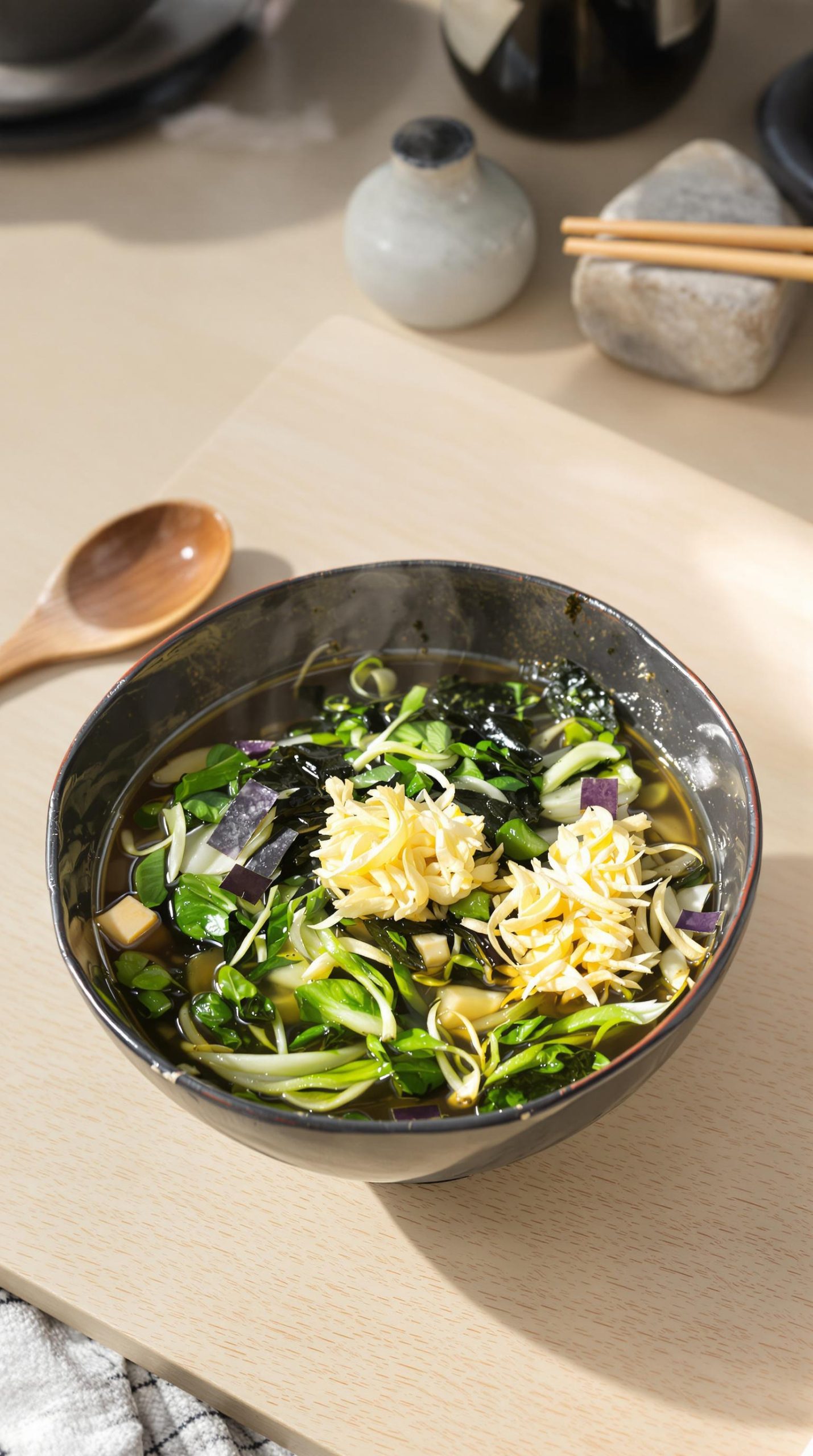Why You’ll Love this Traditional Japanese Miso Soup
When you’re craving something warm, nourishing, and authentically Japanese, this traditional miso soup is exactly what you need.
I’m obsessed with how quickly it comes together—just 10 minutes from start to finish! The umami-rich miso paste creates this incredible depth of flavor, while the wakame seaweed adds a subtle oceanic taste.
What I love most is how customizable it is. Don’t have watercress? Swap in spinach.
Need more protein? Toss in some tofu cubes.
And can we talk about that hint of ginger? It adds the perfect warming note that makes this soup feel like a hug in a bowl.
What Ingredients are in Traditional Japanese Miso Soup?
Traditional Japanese miso soup is a marvel of simplicity and flavor. The key to its magic lies in the quality of just a handful of ingredients working in perfect harmony. I find that having everything prepped and ready makes this soup come together in minutes, which is perfect for busy weeknights when I need something nourishing without much fuss.
The beauty of this recipe is how these traditional ingredients create something far greater than the sum of their parts.
- 1 tablespoon miso paste
- 3 inches wakame seaweed strip
- 2 leaves Chinese cabbage, finely chopped
- 1 handful watercress, finely chopped
- 2 sheets nori seaweed, cut into fine strips
- 1/2 teaspoon grated ginger
- 4 cups water
When shopping for these ingredients, the miso paste is definitely where you want to focus your attention. There are different varieties—white, yellow, and red—each with varying intensity of flavor.
White miso (shiro) is milder and slightly sweet, perfect if you’re new to miso soup. Red miso (aka) has a stronger, saltier profile. The seaweed elements might seem intimidating if you haven’t used them before, but they’re readily available in Asian grocery stores or the international section of many supermarkets.
And remember, the fresher your ginger, the brighter your soup will taste. Give it a sniff—it should smell zingy and potent.
How to Make this Traditional Japanese Miso Soup

Making traditional miso soup is all about technique and timing. I start by soaking 3 inches of wakame seaweed strip in cold water for about 2 minutes—this quick bath transforms it from rigid to silky.
While that’s happening, I bring 4 cups of water to a gentle boil in a saucepan, then reduce the heat to maintain a steady simmer. The wakame goes into the simmering water next, where it needs about 3 minutes to release its oceanic essence into the broth.
Now comes the most critical step: properly incorporating 1 tablespoon of miso paste. Never add miso directly to boiling water—the high heat destroys its delicate flavor compounds and beneficial enzymes.
Instead, place the miso in a small cup, add about 2 tablespoons of cold water, and whisk until smooth. This creates a slurry that integrates beautifully into the soup. Add this mixture to the pan, stir gently, and let it simmer (never boil) for just 1 minute.
Finally, add 1 handful of finely chopped watercress and 2 finely chopped Chinese cabbage leaves, then immediately turn off the heat. The residual warmth will soften these greens perfectly without overcooking them.
To serve, I ladle the soup into bowls, top with strips of nori seaweed, and crown each serving with a small pinch of freshly grated ginger (about 1/2 teaspoon total). The aroma that rises from the bowl? Pure comfort in vapor form.
Traditional Japanese Miso Soup Substitutions and Variations
While the classic recipe I’ve shared creates an authentic miso soup experience, adaptability is one of miso soup’s greatest strength.
You can swap cabbage with spinach, kale, or bok choy—whatever leafy greens are in your fridge. No wakame? Try other seaweeds like kombu or dulse.
The miso itself offers variety too. White miso brings sweetness, while red miso delivers a deeper, more robust flavor.
Got dietary restrictions? Use chickpea miso for a soy-free version.
For protein, try adding cubed tofu, or turn it into a heartier meal with mushrooms, daikon, or even a soft-boiled egg.
What to Serve with Traditional Japanese Miso Soup
In Japanese cuisine, miso soup rarely stands alone but rather serves as a cornerstone of a well-balanced meal.
I always recommend pairing it with steamed white rice, which absorbs the savory umami flavors beautifully. Add grilled fish like salmon or mackerel for protein, or try tamagoyaki (Japanese rolled omelet) for a milder option.
Pickled vegetables, or tsukemono, provide a tangy contrast that cuts through the richness of the soup. Can you imagine a better palate cleanser?
Small side dishes like edamame or cold tofu complete what’s known as ichiju-sansai—one soup with three dishes—the traditional Japanese meal structure.
Final Thoughts
Miso soup represents the heart and soul of Japanese culinary tradition—a simple yet profound dish that brings warmth to any meal.
I’m continually amazed by how just a few humble ingredients can transform into something so nourishing and satisfying.
What makes this recipe special? Perhaps it’s the delicate balance of umami from the miso paste, the subtle oceanic notes from seaweed, or the fresh brightness of watercress and ginger.
Don’t you find there’s something meditative about preparing soup this way? Slow, intentional, mindful. A reminder that sometimes, the most basic foods offer the deepest comfort.
Unlike a classic pot pie that requires 40 minutes of baking time, miso soup comes together quickly while delivering equally satisfying comfort.
While chicken noodle soup relies on egg noodles for substance, miso soup achieves its character through its deeply flavored broth alone.
Worth every minute.





